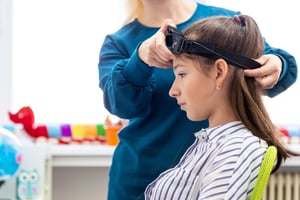
VALUE MEASUREMENT VS. EEG
Electroencephalogram (EEG) is foundational neuroscience that shows patterns of electrical activity, which researchers use to infer certain psychological processes.
WHAT IS ELECTROENCEPHALOGRAM (EEG)?
EEG allows you to record the electrical activity on a person's scalp to represent the activity of the surface layer of the brain. The gear used to measure EEG places electrodes on the head of participants.
In order to get the best results from EEG, a practitioner will use as many electrodes as possible (up to 256!), and likely place a small dot of gel between the node and the scalp in order to improve contact and sensitivity.
In recent years, new "consumer" or "pro-sumer" EEG devices have come to market that reduce the number of electrodes and improve the participant experience. However, when you have fewer electrodes in contact with the scalp, you typically reduce the reliability of the results.
Many neuromarketing providers offer EEG as a method for measuring emotions; however, emotions are complex and involve multiple deep-brain regions and distributed systems. Because EEG detects activity on the scalp, it is challenging to directly correlate EEG to emotion. Most importantly, EEG is a poor predictor of future behavior (we know, we tried it!), and was designed for this purpose.
THE BENEFIT
Medical-grade EEG devices have very good temporal accuracy, meaning you can quickly record electrical activity as it happens.
Newer minimal EEG headwear is less bulky and disrupting than the medical-grade "shower cap" (though it is also significantly less accurate).
THE DRAWBACK
EEG requires an expertly trained professional to fit your subjects’ head with a cap that contains up to 256 electrodes to observe their brain. This experience is uncomfortable and distracts your audience from your content.
Processing data from EEG can take weeks and requires professionals to decipher data.
EEG has poor spatial accuracy, and can therefore not accurately identify where brain activity comes from.
EEG provides an educated guess about active areas of the brain and it's hard to know where to go from there.
With EEG, you can understand when your audience’s brain is activated while viewing your content or partaking in some simple experience. But you cannot quantify whether they are getting value, meaning you can't predict what they will remember or how they will act later.

DINNER PARTY FACT FOR BRAIN NERDS:
EEG was first revealed to the world in 1875 by Richard Caton from Liverpool, England. He wanted to see the brain activity of monkeys and rabbits.
(That's, like, a really long time ago...)
HOW VALUE MEASUREMENT IS DIFFERENT
Value Measurement lets you measure the impact an experience is having while it is unfolding, as individuals experience it naturally in the real world. It does not involve trying to connect electrical activity detected outside of the skull to deep-brain regions, and it doesn't require complicated tools.
Value Measurement passively detects the peripheral footprint of the neurochemicals our brains produce in moments when our brain is fully connected to and getting value from an experience. As a result, you can measure the impact of any experience and predict future action with impeccable accuracy based on the results.
IS IT A VALUE MEASUREMENT?
FEELS LIKE IT'S PURE MAGIC BECAUSE IT'S GOOD SCIENCE
Your brain tells a story. Your smart watch is ready to listen. After more than 20 years of published, peer-reviewed research, we’re connecting the two. Now, using everyday wearable devices to capture activity within the body, we can measure the brain's value throughout the day.
Don't take our word for it. Download the full scientific and academic background.

